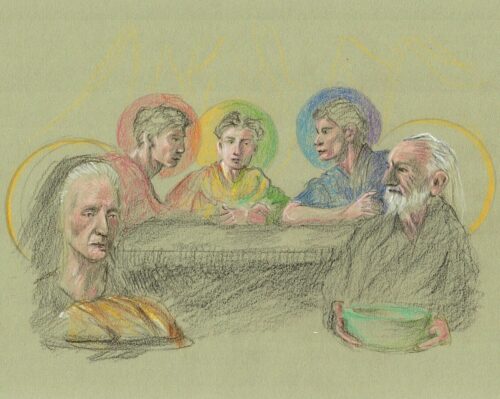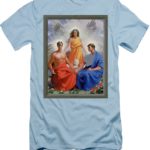Last Updated on January 24, 2025 by Kittredge Cherry

Celebrate Trinity Sunday with visionary LGBTQ resources, including the last image from the gay Passion of Christ series, an icon of a Trinity with rainbow halos, the “Sparkle Creed” and “Rainbow Trinity Prayer.”
The Holy Spirit blesses God and Christ as a same-sex couple in “The Trinity” by Doug Blanchard. The Trinity appears with rainbow halos on the way to Sodom in an icon unveiled in June 2023 by Tobias Haller. This year Trinity Sunday is June 15, 2025.
Holy Spirit blesses same-sex couple as Gay Passion of Christ series ends
A divine same-sex union is pictured in “Trinity,” the last image in Doug Blanchard’s gay Passion of Christ series. Blanchard completed a second gay Passion of Christ series with a darker, racially indeterminate Jesus in 2023.
 Blanchard, A gay New York artist, Blanchard paints a queer version as part of his series about Jesus as a contemporary gay man in a modern city. The 24 paintings in “The Passion of Christ: A Gay Vision” are available as a blog series and book with reflections by Los Angeles lesbian author Kittredge Cherry. The art is also available as prints. The following reflection is an excerpt from the book.
Blanchard, A gay New York artist, Blanchard paints a queer version as part of his series about Jesus as a contemporary gay man in a modern city. The 24 paintings in “The Passion of Christ: A Gay Vision” are available as a blog series and book with reflections by Los Angeles lesbian author Kittredge Cherry. The art is also available as prints. The following reflection is an excerpt from the book.
_________________
“Truly, I say to you, today you will be with me in Paradise.”— Luke 23:43 (RSV)
An angelic figure blesses a gay couple in “The Trinity,” the final, climactic image in Blanchard’s Passion of Christ. The painting can stand alone to affirm the holiness of gay couples, but it also serves as a meditation on the Christian Trinity: one God in three persons. Churches celebrate the concept on Trinity Sunday.
The couple holds hands before a table set with milk, honey, and fruit — references to the Promised Land. The man draped in red reaches toward out, coaxing the viewer to join them in the sunny garden. The winged woman in the golden robe is the same Holy Spirit who arrived in the previous painting. An arch in the background hints at the gate of heaven. Indeed viewers are welcome to imagine themselves seated in paradise with Christ as their bridegroom.
“The Trinity” shows how Jesus has been transformed by his experience of the Passion. He moved from the dark prison of the first painting to a bright land of promise, out of the closet, into the streets, and on to holy bliss. He completed the mythic hero’s journey: martyred and reborn with power to redeem the world. The painting can stand alone to affirm the goodness of same-sex couples, but it also serves as a foretaste of paradise and a meditation on the Christian Trinity: one God in three persons. The artist has said that he intended this image to be “a little glimpse of salvation, of the reward of the faithful.”
The Bible often says that Jesus will ascend to heaven and sit at the right hand of God. By that reckoning, the man in blue must be God, but he is not the usual Father figure of traditional Trinitarian imagery. He doesn’t look like “the Lord” and certainly not old enough to be Jesus’ father. In Blanchard’s universe, God’s identification with humanity is so complete that God and Jesus are identical young lovers in a mystic same-sex marriage, both sharing the same crucifixion wounds. Mission accomplished, they sit together side by side in radical equality. As the historical Christian creeds say, they are “of one substance” and “coeternal, and coequal.”
The Trinity concept is reinforced by the colors of their clothing. The red, blue, and yellow robes are the three primary colors that, when mixed, create the full spectrum of white light. Red, yellow, and blue flowers blossom around them. These are common, garden-variety plants: irises, geraniums — and dandelions! Even weeds are welcome at the feet of Christ. Blanchard’s heaven is just not a faraway, immaterial afterlife, but an earthly garden in this present paradise. The natural setting and robes give it a timeless quality, but there are hints of contemporary life in the glass pitcher and honey jar. The man on the right wears a modern t-shirt under his blue robe.
The term “Trinity” is never used in the Bible, although it is implied in references to Jesus, God, and the Holy Spirit, who is often represented as female. Viewers will be forgiven for wondering which man is Jesus. Blanchard, who is so adept at painting individual faces, gives the same face to all three, even the female Holy Spirit. The artist does this on purpose to emphasize the three-in-one nature of God. BOTH men have haloes and marks of crucifixion on their wrists.
One clue to their identities comes from the way the figures direct their attention. The Holy Spirit and the man in blue focus on the man in red. Their body language suggests that he is Jesus, the center of this series, the one who just completed his heroic Passion journey. Like Christ in Blanchard’s first painting, the man in red gazes straight ahead, meeting the eyes of the viewer. His upper torso is naked, revealing the wound in his side and a radiant, muscular body. Surely this man is Jesus.
The holy gay wedding imagery is especially revolutionary because of its placement in Blanchard’s Passion sequence. After the Ascension and Pentecost, the final position in a Passion cycle normally goes to the Last Judgment. Traditional images show Jesus condemning sinners to hell and sending the righteous to heaven. Conservative Christians like to imagine homosexuals among the damned. But Blanchard rejects the crime-based model. Jesus and God are not on thrones nor do they judge anybody. Indeed Blanchard reverses the whole Christian view of history as presented by countless artists, including his acknowledged inspiration, Albrecht Durer. In his 16th-century Small Passion, Durer began with Adam and Eve eating forbidden fruit and being expelled from Eden as punishment. He ended with the Last Judgment. By contrast Blanchard starts with punishment in prison, and then finds a way to paradise. He chose a prototype for this painting in a separate branch of art history: Andrei Rublev’s great Byzantine icon “Trinity,” which shows the three angels at Abraham’s table. Blanchard’s Passion concludes not with judgment, but with love as its crowning glory.
The symbolism of this image can be better understood in comparison with the first painting, “Son of Man with Job and Isaiah.” The opening picture also forms a kind of Trinity. The two paintings that start and end the series have a lot in common. Unlike the rest of the series, their titles are theological concepts. Both have interrupted the flow of time, mixing modern and ancient dress. Both show Jesus gazing directly into the eyes of the viewer. The first and last images are like brackets that enclose and uphold the events in Christ’s life.
A lot of LGBT people (and others) just plain like “The Trinity,” without seeing it as Christian at all. It was chosen to illustrate the concept of gay friendship on the cover of “White Crane Journal: Gay Wisdom and Culture” in summer 2007. Blanchard’s Trinity is queer in other ways. The whole concept of a three-in-one God with male and female aspects means that that God does not fit the standard “male” and “female” binary, but may be transgender, omnigender, or genderqueer. Medieval mystic Julian of Norwich recorded a vision of God’s own explanation: “I am the power and the Goodness of the Father, I am the Wisdom of the Mother, I am the Light and the Grace which is blessed love, I am the Trinity, I am the Unity.”
Most artists throughout history have not used couples to symbolize the joys of heaven, but some contemporary LGBT artists do. Both Blanchard and Swedish photographer Elisabeth Ohlson Wallin envision same-sex pairs in the afterlife. Ohlson Wallin closes her “Ecce Homo” series with a vision of heaven in which Jesus and his boyfriend are surrounded by a crowd of loving lesbian and gay couples, all clad in white.
After progressing through the whole Passion series, viewers have witnessed God’s solidarity with humankind and seen the power of love to transcend personal suffering, human history, and even death itself. Preconceptions have been shaken by the encounter with Jesus, the wounded healer, the hated lover, the crucified creator, the liberator in chains, the all-too-human child of God. From this post-resurrection space, Christ has regained his complexity. The gay vision of Christ’s Passion leaves viewers with an invitation to rise to a new life where everyone can reach out to others with love as Jesus does. The painting ends the series as a visual benediction, encouraging viewers to carry the vision onward and live with passion in every sense of the word.
Angels with rainbow halos form Trinity
Halos of three angels combine to make all the colors of the rainbow in “The Hospitality of Sarah and Abraham: The Holy Trinity” by Tobias Haller. He unveiled it in June 2023 for Trinity Sunday and Pride Month. It is based on the same Rublev icon that inspired Blanchard’s painting. Haller depicts the story in Genesis 18 when Abraham and Sarah are visited by three angels on their way to Sodom. Christians generally interpret them as an expression of the Trinity.

“The Hospitality of Sarah and Abraham: The Holy Trinity” by Tobias Haller
When two of the angels arrive in Sodom, they are threatened with rape, evoking divine wrath. This story has often been misinterpreted as a condemnation of homosexuality. “Modern readers see this also as an early example of homophobic assault: that is, the villagers perceive the beautiful young men as ‘gay’ and so want to teach them a murderous lesson. Given things in Uganda these days, it is a good reminder that as we do to the least of those among us, we do to God,” Haller wrote when he shared the artwork on his Facebook page.
Haller an iconographer, author, composer, and retired vicar of Saint James Episcopal Church in the Bronx, still assisting at a parish in Baltimore, Maryland.
Sparkle Creed
An LGBTQ vision of the Trinity is expressed in the Sparkle Creed by Rachel Small Stokes, a United Church of Christ pastor in Tennessee. She was voice-to-texting the Apostle’s Creed to a colleague and the software transcribed it as the Sparkle Creed. “I decided that’s exactly what we need for Pride Month,” Stokes wrote in the Facebook post where she shared it with the world. Here is the creed:
I believe in the non-binary God whose pronouns are plural.
I believe in Jesus Christ, their child, who wore a fabulous tunic and had two dads, and who saw everyone as a sibling of God.
I believe in the rainbow Spirit, who shatters our image of one white light and refracts it into a rainbow of gorgeous diversity.
I believe in the church of everyday saints, as numerous, creative, and resilient as patches on the AIDS quilt, whose feet are grounded in mud and whose eyes gaze at the stars in Wonder.
I believe in the calling to each of us, that love is love is love, so beloved, let us love.
I believe, glorious God. Help my unbelief. Amen.
Rainbow Trinity Prayer
The following Rainbow Trinity Prayer was written by Bronwyn Angela White, a poet and liturgist based in Aotearoa New Zealand. Her website SpiritAndFaithwords.com offers resources that affirm inclusiveness and social justice for an evolving, progressive Christianity. She is the author of “You Who Delight Me” and “Something New to Say: Words of Spirit, Faith and Celebration for Advent and Christmas.”
“O God who we create from the sum of all we know that is wonderful, generous, true and wise; Creative spirit, Goddess and Gaia, we see ourselves in the god-ness of others, and ourselves in their image of you.
Sophia Wisdom, who changes through time, who appears in different guises, in wind and fire, in storm and in stranger, whose names are numerous and whose voices are many, may we hear you in canticles and ballads, workers’ songs and lullabies, see the Rainbow Evolution in diverse creatures and flourishing lives.
Oh Christ who manifests in rainbow ways, as ancient wisdom and holy fool, as genderqueer, cis and bi, ungendered, straight: diverse and beautiful; as rabbi, story-spinner, joker and sage:
Be in us as we colour outside the lines. Be in the songs we sing, the wine we pour, the food we share.
Amen”
___
Top image credit:
24. The Trinity (from The Passion of Christ: A Gay Vision) by Douglas Blanchard
___
This is part of the series “The Passion of Christ: A Gay Vision.”
The Passion series features 24 paintings by Douglas Blanchard, with text by Kittredge Cherry. It is also available as a book and prints.
 “The Trinity” is available now on mugs, t-shirts, phone cases, notebooks, tote bags and a variety of other products at Pixels.com. So are all the other images in the gay Passion of Christ series.
“The Trinity” is available now on mugs, t-shirts, phone cases, notebooks, tote bags and a variety of other products at Pixels.com. So are all the other images in the gay Passion of Christ series.
Copyright © Kittredge Cherry. All rights reserved.
Qspirit.net presents the Jesus in Love Blog on LGBTQ spirituality.
___
Related links:
The Genderqueer Trinity (Queering the Church)
Saint Francis rejoiced when all-female Trinity called him “Lady Poverty” (Q Spirit)
___
This article was originally published on Q Spirit in April 2017, was expanded with new material over time, and was most recently updated on Jan. 24, 2025.
Scripture quotations are from the Inclusive Language Lectionary, copyright © 1985-88 National Council of the Churches of Christ in the United States of America.





















Dear Kittredge Cherry, thanck for the emails with theese information. My interest is know the possibility obtain the informnation in spanish language- It is possible? Thank in advance for your information. Sincerely Your, Koniko from Chile, South America.
Dear Koniko,
Yes, I have a Spanish-language blog called Santos Queer with translations of many articles at
http://santosqueer.blogspot.com/